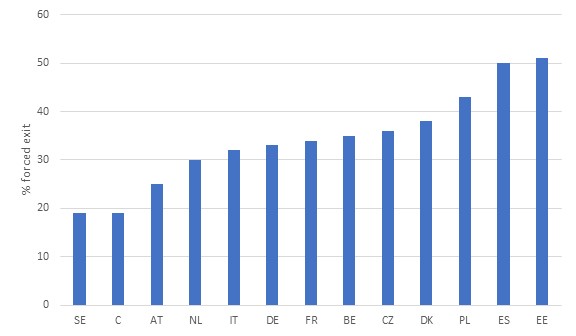
Martin Hyde, PhD Center for Innovative Ageing, Swansea University & Ellen Dingemans, PhD Netherlands Interdisciplinary Demographic Institute
Research on retirement is burgeoning. Yet, despite concerted efforts by governments throughout the world to encourage people to remain in work up to and beyond pension age, there are still concerns that many older workers are being forced leave their jobs. We were keen to investigate this and look at the potential ways in which measures to increase labor market participation might create new forms of forced expulsion from the labor market. Previous research has demonstrated that social security and pension systems provide incentives for people to retire early. However, pension systems are only one part of the policy mix that can impact labor force participation in later life. Our study looked at the role that employment protection legislation (EPL) plays.
Both the Organisation for Economic Co-operation and Development and the European Commission have identified EPL as an important determinant of the employment situation of older workers. To look at EPL’s impact on forced exit from work, we needed a sample of countries with different levels of EPL. It is harder and costlier to fire workers in countries with high levels of EPL than it is in countries with low levels of EPL. For our analyses, we used data on 13 countries from the Survey of Health, Aging and Retirement in Europe (SHARE). The EPL measure was taken from the OECD.
Our main focus was on whether the strictness of EPL affected whether workers who were forced out of work were forced out via retirement or nonretirement routes, such as unemployment. In line with our expectations, we found that there was substantial variation in the rate of forced exit from work, ranging from about a fifth of older workers in Sweden to about a half of older workers in Spain and Estonia (see Figure 1). When we looked at the relationship between EPL and the route of forced exit, we found that higher levels of EPL were associated with a greater likelihood of being forced out of work via retirement rather than nonretirement routes. Our interpretation of these findings is that laying off older workers prior to retirement is much more expensive where EPL is strict, because of higher severance payouts. In this situation, retirement then becomes an attractive alternative, both because it is cheaper for the employer and because it is a more legitimized route of exit. These findings suggest that in countries with stricter EPL, policymakers need to ensure that there is also sufficiently strong legislation to prevent employers from forcing older workers out through retirement.
Link to the original article: https://academic.oup.com/workar/article/3/3/231/3863076
Figure 1. Proportion of older adults who were forced to leave their jobs, by country

Authors
Martin Hyde, PhD
Center for Innovative Ageing, Swansea University
Twitter: @HydeM1976
Email: Martin.hyde@swansea.ac.uk
Ellen Dingemans, PhD
Netherlands Interdisciplinary Demographic Institute
Email: Dingemans@nidi.nl

Figure 1. Proportion of older adults who were forced to leave their jobs, by country

